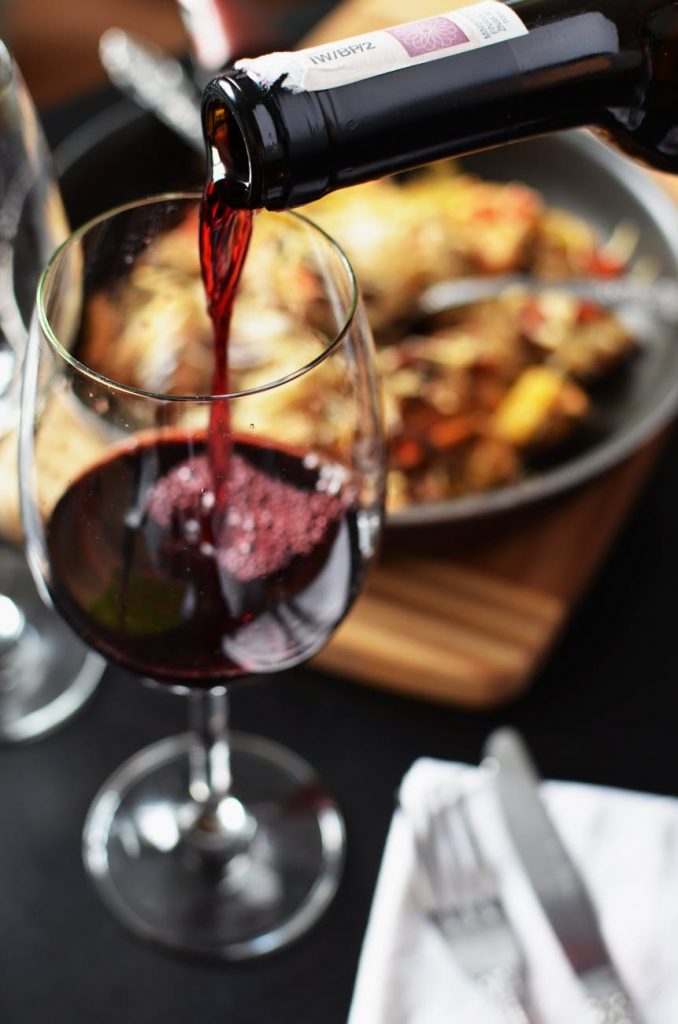Dry red wines do not contain any residual sugar and are not sweet, hence, the name “dry red.” Wine manufacturers intentionally stop the process of fermentation in the mid-way to allow some residual sugars to accumulate and sweeten the red wine. On the other hand, dry red wines go through the entire cycle of fermentation, in which the yeast has utilized all the sugar content of the grapes. Different genres of dry red wines are discussed below.
1. Bordeaux-Style
They are usually tannic and come with a sophisticated blend of dark fruits. Typical aromas and flavors of this wine include leather, dark cherry, stone fruits and tobacco. Many of these Bordeaux-style spirits age pretty well due to their dense, tannic core. They can be paired with fatty red meats and steak. Noteworthy manufacturers who produce Bordeaux-style red wines are Bordeaux, Tuscany, California, Washington State and South America.
These structured, lush, tannic red wines are made from grapes grown at the Bordeaux in France. The essential grapes found in this type of wines include:
Cabernet Sauvignon
These wines happen to be very hearty and come with loads of tannins and are usually blended with Cabernet Franc and Merlot grapes. One can never go wrong with flavors like herbs, green olive, bell pepper or black cherry. It can be paired with hearty dishes and red meats.
Merlot
This soft red retains its purity when produced in Bordeaux, though some regions have manufactured mediocre wines, and diluted its brand equity in the process. New World Merlots like Washington State is worth trying. Merlot wines typically come with flavor profiles like watermelon, plum, cherry, and strawberry. Cabernet is more tannic than Merlot. Beef, pork, roasted chicken and vegetarian dishes; almost anything can be paired with a Merlot.
Cabernet Franc
This is necessarily a kind of blending grapes mixed with Cabernet Sauvignon and Merlot wines. However, it is also a stellar standalone wine. It grows in abundance at the Loire Valley in France. This bold wine usually offers flavor profiles of plum and raspberry accompanied by herbaceous and leafy notes. It can be paired with roasted beef, pork, and duck.
Malbec
Though it is a type of blending grapes cultivated in Bordeaux, it is being grown Argentina these days and has achieved an iconic status there. Malbec comes with standard flavors like spice and sour cherry. It can be paired grilled meats, pasta, and pizzas.
Petit Verdot
It is a standard blending grape sourced from Bordeaux, but one can spot some Petit Verdot wines, especially under the “New World” category. These grapes happen to possess violet aromas and also flavors of spice. It can be paired with meats, sausages, and hard cheeses.
Carménère
Though Carménère hails from Bordeaux, it has made Chile its second home. The vines went extinct in the 1800s in France by an outbreak of phylloxera root louse. It is put to use in the Bordeaux-style blends of red wine, and Chilean manufacturers are making spicy and fruity wines. It can be paired with beef, sausage, and lamb.
2. Rhône-Style
They happen to be intensely aromatic, smoky, and spicy with bold flavors of fruits. Typical aromas and flavors include peppers, smoked meats, stone fruits, cherries, nutmeg, and spices. These Rhône-style wines are accessible and savory. Being dependant on their tannic core, many of them age pretty well, though also can be beautifully drunk when they are youth. These wines can be paired with cured (bacon and ham) and smoked meats, dark meats, braises and also game meats. Apart from the Rhône, one can find these wines in Australia, California, Washington State and Priorat in Spain.
These wines are made from grapes obtained from the Rhône in France. Typical wines and grapes from France’s Rhône Valley include:
Grenache
It is famous grape required for preparing red wines; and are grown in Australia, France, and also in the aforementioned Rhone Valley. Standard grapes that can be found in Rhône-style wines are Syrah, Cinsault, and Mourvèdre. It happens to be the primary component for premium wines like Côtes du Rhône and Chateauneuf du Pape. Grenache usually comes with flavors of cherry and spice, accompanied by earthy notes. It can be paired with barbeque, duck, grilled lamb and vegetarian items like eggplant.
Syrah
Syrah; also known as Shiraz in some regions; offers flavors of boysenberry, blackberry, clove, pepper, and plum. It happens to be a versatile and intense type of grapes that are used in the preparation of fruity and light to spicy and thick wines. The taste and aromas are heavily influenced by the local climate, and one can find subtle differences in flavor profiles even within Rhône Valley. Wines from Northern Rhône are typically filled with delicious black fruits or are made to soften with the help of white grape Viognier. In Côte Rôtie and Hermitage, the wines are characterized by a distinctly earthy flavor, similar to tobacco. But in Southern Rhône, the Syrah still possesses spice and pepper, yet adding Grenache often bestows it with a red fruity flavor and reduces its sourness. It can be paired with steak, tomato-rich barbeque sauces, mushrooms and hard cheeses.
Mourvèdre
It is called as Monastrell in Spain, the country where it was originated, but it is necessarily a kind of blending grapes found in the Rhône Valley. These wines happen to be intense; and offer flavors of black currant, blackberry, and tannic. Apart from the Chateauneuf du Pape, it is witnessed in “GSM” (Grenache, Syrah, and Mourvèdre ) wines. It can be paired with vegetable stew, roasted lamb, and braised or grilled beef.
Cinsault
It hailed from Southern Rhône and used for the preparation of fruity and light wines. Additionally, it is used along with Grenache and meant for the mostly rosé zone of Tavel appellation. It is a heat-loving and high-yield grape, and hence, is immensely popular for blends. It can be paired with ethnic dishes from the Mediterranean and light desi (Indian) cuisine, accompanied by pork and grilled chicken.
3. Burgundy-Style
Single grapes are used for the preparation of Burgundian reds. Wines manufactured from Pinot Noir can be silky and smooth or unctuous and strong, and depends on the winemaker’s style and also on the place where these grapes are cultivated. These earthy spirits contain aromas and flavors of tobacco, dark cherries, berries and mushrooms. They have smooth and well-integrated tannins, yet, they age comparatively well. They can be paired with salmon, lamb, mushrooms, dark meat and duck. As it is fragile and not easy to cultivate in some places, it is suggested to stick to regions which have a solid reputation for making Pinot Noirs of premium quality. Oregon and California are the two places outside Burgundy that pride at manufacturing stellar Pinot Noirs. One can also find good quality Pinot Noirs from Australia and New Zealand.

